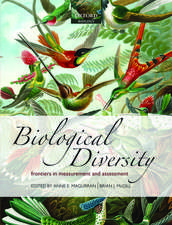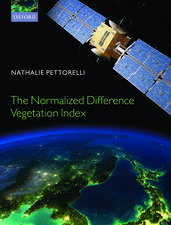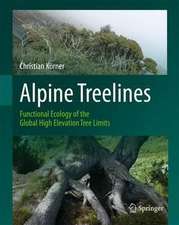Alpine Plant Life: Functional Plant Ecology of High Mountain Ecosystems
Autor Christian Körneren Limba Engleză Paperback – 2 apr 2022
This book is a completely revised, substantially extended treatment of the physical and biological factors that drive life in high mountains. The book covers the characteristics of alpine plant life, alpine climate and soils, life under snow, stress tolerance, treeline ecology, plant water, carbon, and nutrient relations, plant growth and productivity, developmental processes, and two largely novel chapters on alpine plant reproduction and global change biology. The book explains why the topography driven exposure of plants to dramatic micro-climatic gradients over very short distances causes alpine biodiversity to be particularly robust against climatic change. Geographically, this book draws on examples from all parts of the world, including the tropics. This book is complemented with novel evidence and insight that emerged over the last 17 years of alpine plant research. The number of figures – mostly in color – nearly doubled, with many photographs providing a vividimpression of alpine plant life worldwide.
Christian Körner was born in 1949 in Austria, received his academic education at the University of Innsbruck, and was full professor of Botany at the University of Basel from 1989 to 2014. As emeritus Professor he is continuing alpine plant research in the Swiss Alps.
| Toate formatele și edițiile | Preț | Express |
|---|---|---|
| Paperback (2) | 435.39 lei 38-44 zile | |
| Springer International Publishing – 2 apr 2022 | 435.39 lei 38-44 zile | |
| Springer Berlin, Heidelberg – 22 aug 2014 | 436.18 lei 38-44 zile | |
| Hardback (2) | 579.55 lei 38-44 zile | +47.25 lei 4-10 zile |
| Springer International Publishing – apr 2021 | 636.09 lei 3-5 săpt. | +47.25 lei 4-10 zile |
| Springer Berlin, Heidelberg – 14 iul 2003 | 579.55 lei 38-44 zile |
Preț: 435.39 lei
Preț vechi: 537.52 lei
-19% Nou
Puncte Express: 653
Preț estimativ în valută:
83.32€ • 86.67$ • 68.79£
83.32€ • 86.67$ • 68.79£
Carte tipărită la comandă
Livrare economică 11-17 aprilie
Preluare comenzi: 021 569.72.76
Specificații
ISBN-13: 9783030595401
ISBN-10: 3030595404
Pagini: 500
Ilustrații: XIX, 500 p. 319 illus., 283 illus. in color.
Dimensiuni: 178 x 254 x 32 mm
Greutate: 1.03 kg
Ediția:3rd ed. 2021
Editura: Springer International Publishing
Colecția Springer
Locul publicării:Cham, Switzerland
ISBN-10: 3030595404
Pagini: 500
Ilustrații: XIX, 500 p. 319 illus., 283 illus. in color.
Dimensiuni: 178 x 254 x 32 mm
Greutate: 1.03 kg
Ediția:3rd ed. 2021
Editura: Springer International Publishing
Colecția Springer
Locul publicării:Cham, Switzerland
Cuprins
PRELIMINARY (ToC of second edition) 1 Plant ecology at high elevations.- The concept of limitation.- A regional and historical account.- The challenge of alpine plant research.- 2 The alpine life zone.- Altitudinal boundaries.- Global alpine land area.- Alpine plant diversity.- Origin of alpine floras.- Alpine growth forms.- 3 Alpine climate.- Which alpine climate.- Common features of alpine climates.- Regional features of alpine climates.- 4 The climate plants experience.- Interactions of relief, wind and sun.- How alpine plants influence their climate.- The geographic variation of alpine climate.- 5 Life under snow: protection and limitation.- Temperatures under snow.- Solar radiation under snow.- Gas concentrations under snow.- Plant responses to snowpack.- 6 Alpine soils.- Physics of alpine soil formation.- The organic compound.- The interaction of organic and inorganic compounds.- 7 Alpine treelines.- About trees and lines.- Current altitudinal positions of climatic treelines.- Treeline-climate relationships.- Intrazonal variations and pantropical plateauing of alpine treelines.- Treelines in the past.- Attempts at a functional explanation of treelines.- A hypothesis for treeline formation.- Growth trends near treelines.- Evidence for sink limitation.- 8 Climatic stress.- Survival of low temperature extremes.- Avoidance and tolerance of low temperature extremes.- Heat stress in alpine plants.- Ultraviolet radiation — a stress factor.- 9 Water relations.- Ecosystem water balance.- Soil moisture at high altitudes.- Plant water relations — a brief review of principles.- Water relations of alpine plants.- Desiccation stress.- Water relations of special plant types.- 10 Mineral nutrition.- Soil nutrients.- The nutrient status of alpine plants.- Nutrient cycling and nutrient budgets.- Nitrogen fixation.- Mycorrhiza.- Responses of vegetation to variable nutrient supply.- 11 Uptake and loss of carbon.- Photosynthetic capacity of alpine plants.- Photosynthetic responses to the environment.- Daily carbon gain of leaves.- The seasonal carbon gain of leaves.- C4 and CAM photosynthesis at high altitudes.- Tissue respiration of alpine plants.- Ecosystem carbon balance.- 12 Carbon investments.- Non-structural carbohydrates.- Lipids and energy content.- Carbon costs of leaves and roots.- Whole plant carbon allocation.- 13 Growth dynamics and phenology.- Seasonal growth.- Diurnal leaf extension.- Rates of plant dry matter accumulation.- Functional duration of leaves and roots.- 14 Cell division and tissue formation.- Cell size and plant size.- Mitosis and the cell cycle.- From meristem activity to growth control.- 15 Plant biomass production.- The structure of alpine plant canopies.- Primary productivity of alpine vegetation.- Plant dry matter pools.- Biomass losses through herbivores.- 16 Plant reproduction.- Flowering and pollination.- Seed development and seed size.- Germination.- Alpine seed banks and natural recruitment.- Clonal propagation.- Alpine plant age.- Community processes.- 17 Global change at high elevation.- Alpine land use.- The impact of altered atmospheric chemistry.- Climatic change and alpine ecosystems.- References (with chapter annotation).- Taxonomic index (genera).- Geographical index.- Color plates.- Plant life forms.- The alpine life zone.- Environmental stress.- The human dimension.
Recenzii
“For me, the greatest appeal of this book is its strong anchoring in our shared cultural history of scientific research on alpine systems and its more personal, respectful attention towards alpine plants. … Körner’s book provides a valuable reference that points to how we may consider modifying our interactions to support the long-term integrity of life at the edges of the earth. … it provides motivation and tools for improving our responsible stewardship of life beyond the treeline.” (Jill Johnstone,Mountain Research and Development, Vol. 41 (4), 2021)
Notă biografică
Christian Körner was born in 1949 in Austria, received his academic education at the University of Innsbruck, and was full professor of Botany at the University of Basel from 1989 to 2014. As emeritus Professor he is continuing alpine plant research in the Swiss Alps.
Textul de pe ultima copertă
This book is a completely revised, substantially extended treatment of the physical and biological factors that drive life in high mountains. The book covers the characteristics of alpine plant life, alpine climate and soils, life under snow, stress tolerance, treeline ecology, plant water, carbon, and nutrient relations, plant growth and productivity, developmental processes, and two largely novel chapters on alpine plant reproduction and global change biology. The book explains why the topography driven exposure of plants to dramatic micro-climatic gradients over very short distances causes alpine biodiversity to be particularly robust against climatic change. Geographically, this book draws on examples from all parts of the world, including the tropics. This book is complemented with novel evidence and insight that emerged over the last 17 years of alpine plant research. The number of figures – mostly in color – nearly doubled, with many photographs providing a vivid impression of alpine plant life worldwide.
Christian Körner was born in 1949 in Austria, received his academic education at the University of Innsbruck, and was full professor of Botany at the University of Basel from 1989 to 2014. As emeritus Professor he is continuing alpine plant research in the Swiss Alps.
Caracteristici
Presents a unique and comprehensive treatment of plant ecology in high mountain regions of all parts of the world Is the fully revised third edition of this successful textbook Contains many photographs and line drawings, most of them in color
Descriere
Descriere de la o altă ediție sau format:
Recent years have seen renewed interest in the fragile alpine biota. The International Year of Mountains in 2002 and numerous international programs and initiatives have contributed to this. Since nearly half of mankind depends on water supplies originating in mountain catchments, the integrity and functional signi?cance of the upland biota is a key to human welfare and will receive even more attention as water becomes an increasingly limited resource. Intact alpine vegetation,as the safeguard of the water towers of the world, is worth being well understood. This new edition of Alpine Plant Life is an update with over 100 new references,new diagrams, revised and extended chapters (particularly 7, 10, 11, 12, 16, 17) and now also offers a geographic index. My thanks go to the many careful readers of the ?rst edition for their most valuable comments, in parti- lar to Vicente I. Deltoro (Valencia) and Johanna Wagner (Innsbruck). Basel,April 2003 Christian Körner Preface to the ?rst edition One of the largest natural biological experiments, perhaps the only one replicated across all latitudes and all climatic regions,is uplift of the la- scape and exposure of organisms to dramatic climatic gradients over a very short distance, otherwise only seen over thousands ofkilometers of poleward traveling. Generations of plant scientists have been fascinated by these natural test areas,and have explored plant and ecosystem responses to alpine life conditions. Alpine Plant Life is an attempt at a synthesis.
Recent years have seen renewed interest in the fragile alpine biota. The International Year of Mountains in 2002 and numerous international programs and initiatives have contributed to this. Since nearly half of mankind depends on water supplies originating in mountain catchments, the integrity and functional signi?cance of the upland biota is a key to human welfare and will receive even more attention as water becomes an increasingly limited resource. Intact alpine vegetation,as the safeguard of the water towers of the world, is worth being well understood. This new edition of Alpine Plant Life is an update with over 100 new references,new diagrams, revised and extended chapters (particularly 7, 10, 11, 12, 16, 17) and now also offers a geographic index. My thanks go to the many careful readers of the ?rst edition for their most valuable comments, in parti- lar to Vicente I. Deltoro (Valencia) and Johanna Wagner (Innsbruck). Basel,April 2003 Christian Körner Preface to the ?rst edition One of the largest natural biological experiments, perhaps the only one replicated across all latitudes and all climatic regions,is uplift of the la- scape and exposure of organisms to dramatic climatic gradients over a very short distance, otherwise only seen over thousands ofkilometers of poleward traveling. Generations of plant scientists have been fascinated by these natural test areas,and have explored plant and ecosystem responses to alpine life conditions. Alpine Plant Life is an attempt at a synthesis.

















